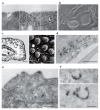Pathways of clathrin-independent endocytosis
- PMID: 17609668
- PMCID: PMC7617177
- DOI: 10.1038/nrm2216
Pathways of clathrin-independent endocytosis
Abstract
There are numerous ways that endocytic cargo molecules may be internalized from the surface of eukaryotic cells. In addition to the classical clathrin-dependent mechanism of endocytosis, several pathways that do not use a clathrin coat are emerging. These pathways transport a diverse array of cargoes and are sometimes hijacked by bacteria and viruses to gain access to the host cell. Here, we review our current understanding of various clathrin-independent mechanisms of endocytosis and propose a classification scheme to help organize the data in this complex and evolving field.
Conflict of interest statement
The authors declare no competing financial interests.
Figures






References
-
- Pearse BM. Clathrin: a unique protein associated with intracellular transfer of membrane by coated vesicles. Proc Natl Acad Sci USA. 1976;73:1255–1259. doi: 10.1073/pnas.73.4.1255. [Describes the isolation of highly purified coated vesicles from different sources and demonstrates that clathrin is the major coat protein, setting the stage for mechanistic studies of a prototypic coated-pit pathway] - DOI - PMC - PubMed
-
- Roth MG. Clathrin-mediated endocytosis before fluorescent proteins. Nature Rev Mol Cell Biol. 2006;7:63–68. - PubMed
-
- Traub LM. Common principles in clathrin-mediated sorting at the Golgi and the plasma membrane. Biochim Biophys Acta. 2005;1744:415–437. - PubMed
Publication types
MeSH terms
Substances
Grants and funding
LinkOut - more resources
Full Text Sources
Other Literature Sources

